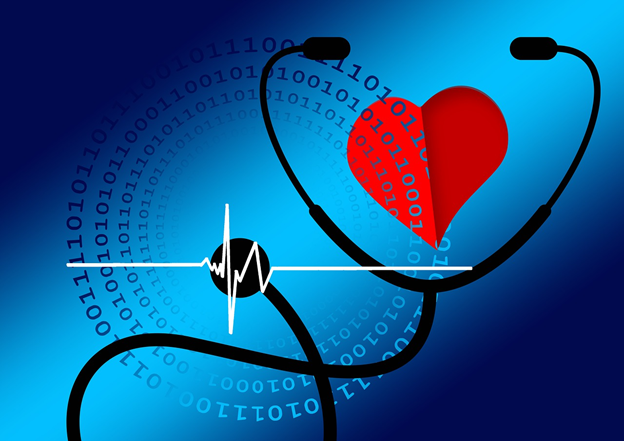Source: Pixabay (https://pixabay.com/illustrations/digitization-healthcare-health-6939536/)
You don’t have to hold a degree in IT to understand the profound impact that technology has had on today’s world. Nearly every aspect of our daily lives is in some way shaped and defined by tech innovation, from the ways we shop and socialize to the ways we receive our education and earn our living.
By Indiana Lee
But perhaps nowhere are the benefits of modern technology more apparent, or more profound, than in the domains of pharmaceuticals and healthcare. Not only are these tools dramatically improving patient safety, but they’re also revolutionizing the way pharmacists and healthcare providers do their work. Indeed, the future of pharmaceuticals and healthcare is increasingly tech-driven, a reality from which we all stand to benefit.
Increasing Access to Healthcare
Perhaps one of the most promising attributes of technology for the future of healthcare is its tremendous capacity to increase patients’ access to care. Every day, new, more functional and powerful telehealth technologies are emerging to promote secure, consistent, and high-quality healthcare provided from the comfort of the patient’s own home.
In addition to the ability for patients to access their healthcare team securely through remote video conferencing platforms, nurses and physicians can also keep nearly constant watch over the patient’s status. These remote monitoring applications can help practitioners track symptoms of illness, identify signs of a nascent problem, and even receive real-time alerts of potentially life-threatening changes in the patient’s vital signs, allowing a home health aid or first responder to be immediately dispatched to the patient’s residence if needed.
As the use of these remote and virtual patient care technologies continues to increase, long-standing and dangerous gaps in the healthcare system will shrink. Patients who have traditionally been denied access to consistent, quality care, including the elderly, persons with disabilities, and those who live in rural areas, can now connect with their healthcare team at the touch of a button.
Enhancing Pharmacy Operations
In addition to helping to overcome healthcare access disparities, existing and emerging technologies are also increasing pharmacy and healthcare workers’ efficiency and efficacy. For example, pharmacists can now deploy automatic dispensing cabinets to promote both speed and accuracy in medication fulfillment.
Best of all, the digitalization of pharmacy operations is improving the ability of pharmacists and healthcare providers to track and monitor patients’ prescription drug activities system-wide, promoting patient safety by immediately alerting care teams to potential errors, misuse, and abuse.
Technology doesn’t just benefit the pharmaceutical industry by supporting drug dispensing and monitoring, however. Robotics, for example, are increasingly being used in the manufacturing of pharmaceuticals, a fact that promises to revolutionize the production of low-cost, superior quality drugs.
Managing Risks
Those who work in the fields of both pharmaceuticals and healthcare must, inevitably, deal with a great deal of risk, from the potential for errors in patient care to the health threats posed to the workers themselves through the handling of hazardous materials. Technology, though, is proving instrumental in mitigating those risks.
For example, technology can be used to great effect to train workers in the safe use and disposal of hazardous materials, including biohazards such as blood products or contaminated medical waste. Similarly, technological advancements in personal protective equipment (PPE) can help keep healthcare providers safer than ever before, even in the face of some of the world’s most virulent pathogens.
In addition to reducing the risks that workers in these fields may face, technology is also helping to reduce threats to patients, particularly those deriving from medical errors or misdiagnoses. For instance, state-of-the-art technologies, such as Artificial Intelligence (AI) systems are increasingly being used to aid in diagnosis and treatment planning.
Through a combination of machine learning and the deployment of literally billions of pieces of Big Data, AI can help healthcare providers to more efficiently and accurately diagnose patients and formulate highly personalized and evidence-based patient care strategies. The result, experts predict, will be far better patient outcomes and lower mortality rates through proactive, individualized care.
The Takeaway
The technological revolution has come and there are no signs of its abating anytime soon. And with our technological era have come exciting new ways of living. But perhaps the most important and exciting rewards of the technological era lie in their capacity to revolutionize the pharmacy and healthcare industries. Thanks to new and emerging technologies, patients can enjoy greater access than ever before to consistent, high-quality healthcare.
Not only this, but healthcare providers can now draw on an array of technological resources, such as remote monitoring devices and telehealth platforms, to maximize the quality of care. At the same time, technological advances in the manufacturing, dispensing, and monitoring of prescription drugs are helping to drive down costs, increase efficiency, and galvanize patient safety.
In addition, the use of AI systems in healthcare is supporting diagnosis and treatment planning, enabling the kind of proactive and personalized care so instrumental to patient health, recovery, and longevity.
Pharmaceutical Microbiology Resources (http://www.pharmamicroresources.com/)




Great post!
ReplyDeleteThis blog it is very helpful for us. Enhance the quality of life for elderly individuals with our specialized aged care physiotherapy services in Melbourne at Well Care Physio.
ReplyDeleteAged Care Physiotherapy in Melbourne